Yesterday marked the official launch of expanded text ads from Google. If you’re unsure what these ads entail, read our recent blog post to learn the ins and outs.
Just to give a very brief rundown, the new ads feature more than double the headline space (60 vs. 25 characters), a longer description (80 vs. 70 characters), and the ability to customize a URL path to drill even deeper into your website and guide search traffic exactly where it needs to go.
Google’s expanded text ads have been in beta since the end of May, but only a small selection of advertisers actually got to see their effects. Now that they are live to everyone, it’s important to know what you can do to maximize their effectiveness. Here are a few tips to help you improve their performance.
Using More Characters Builds Character
The new Google text ads have more than double the characters for a headline. Use them! Not only will you be able to increase ad relevance and fine-tune your message, you’ll also be increasing the actual area that your ads can be clicked. A longer headline means a larger clickable zone. This is extra useful on mobile, where screen size is smaller and space is at a premium.
This goes for your description as well. Though you are only getting 10 more characters, put them to good use! Take this opportunity to further flesh out your ad copy and knock it out of the park.
Keywords are Your Friend
While you’re thinking up your home run copy, make sure that you are adding in relevant keywords, where applicable, to maximize your ads reach in as many search queries as possible. You don’t want to keyword stuff your entire description obviously, as that does not make for compelling copy. But using your description to be, well, descriptive, allows you to create more successful ads that will pull in the traffic you are looking for and convert at a higher level.
Don’t Pull Your Old Ads
You may be super excited about Google’s expanded text ads, but that doesn’t mean you should immediately pull your old ads. It’s going to take time for you to test out what works and what doesn’t. Leave your old ads running until you can collect enough data to analyze what is most successful. Not every business is the same, and what may work for some won’t work for others, so bear that in mind as you roll out the new expanded text ads.
Testing, Testing… Is This Thing On?
Speaking of testing, you should be doing it like it’s your job with this new format. Because it probably is your job, isn’t it? Running multiple tests with different copy is essential to creating winning expanded text ads. Although Google has given you the template for success, it’s still up to you to create compelling copy, write a strong headline, and figure out the right balance in your description.
Running A/B tests or split tests will be essential in this early stage to determine what works and what doesn’t. Don’t be discouraged if your expanded text ads under-perform initially. As the old cliché goes, “Rome wasn’t built in a day.”
Link Me Up, Before You Go Go
In the old text ads, Google required you to manually enter the display URL. Any mismatch between the display and the final landing page would cause your ad to fail Google’s inspection and would not be approved.
Now, the domain is automatically extracted from the final URL. You’re given two additional fields (up to 15 characters each) to customize your path. This allows you to be far more specific with your URL and tailor it to your search terms. It’s basically two free fields to enhance your ad and bring your traffic to a more specific page of your website.
These are just a few of the ways that you can maximize Google’s expanded text ads. Google also has a great resource available on their AdWords support page to further elaborate on some of the keys to success with expanded text ads.
To learn even more, schedule a complimentary 20-minute consult with one of our paid search experts to find out more ways to improve your paid search efforts.




